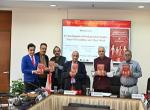During the course of the elections, Dr. A Surya Prakash visited the states of Karnataka, Haryana, Rajasthan, Delhi, Uttar Pradesh and West Bengal to understand how the people were voting. He shared his impression and insight during two round table discussions held at the Vivekananda International Foundation, New Delhi.
Dr. Surya Prakash said that the 2019 Elections can be described as the nation’s first ‘WhatsApp’ election. WhatsApp played a very big role in moulding public opinion for or against the political parties. During his tours, he said he found a strong under-current in all states in favour of Prime Minister Modi. This was particularly discernible in Karnataka, Delhi, Haryana and Rajasthan. There were two distinct reasons which people cited for supporting Mr. Modi. The first was the need for a ‘Majbooth Sarkar and Leader’, the second was the delivery of social sector schemes and development of infrastructure. People said Mr. Modi had got them houses, domestic gas connections, electricity, health insurance, roads etc.
The speaker was of the view that the winds of support for Mr. Modi, originating in the West in Gujarat and Rajasthan, would envelop the entire plains of Central and Northern India – no state in this region would be able to insulate itself from its influence. The Josh of pro-Modi supporters was also unparalleled. The rise of the BJP in West Bengal is another phenomenon. This party has completely dislodged the Communist Party of India (Marxist) as the main opponent of the Trinamul Congress Party (TMC). Communists are in complete disarray and the battle between TMC and BJP is visible on the ground. The Congress Party, which once ruled West Bengal, has become redundant. Modi has strong support from women whose lives have been transformed by toilets and gas cylinders. The toilet revolution had a significant positive impact on the poorer section of the population. The middle-class voters were impressed by IAF strikes on Balakot. In contrast, the opposition did not have a positive agenda.
An interesting debate took place during the Q & A session. Participants wanted to know about polarization in the election, the Election Commission’s role and how Modi 2.0 will look like. The speaker was confident that no majoritarian assertion will happen. Things would settle down. Modi has often spoken about the core values in our Constitution and about how critical democracy is for India as a nation. Dr. Prakash said that apart from Mr. Modi’s strong leadership, the phenomenal rise of the BJP could be attributed to the frequent provocations of a miniscule minority of pseudo secularists who have been the main cause of polarization. He also pointed out that the performance of the Election Commission has come in for a lot of criticism. The election process was too long, leading to a great deal of national stress. It could easily have been compressed.
Participants also felt that the methodologies adopted by Exit Polls were weak and the predictions should be taken with a pinch of salt. The speaker agreed and said in all social surveys, the outcomes depends on the quality of the sample. Exit Polls go wrong when the samples are weak and when the field staff are not properly supervised and monitored.
This election – barring pockets – looks like the election of 1971 when Indira Gandhi won a thumping 353 seats. The ‘Indira Hatao’ call of the Grand Alliance that was pitted against her was wholly rejected by the people. Indira Gandhi was able to cut through barriers of caste, region and religion and secure support across the board. There was a distinct possibility of Mr. Modi doing this in 2019 in the North, Central and Western states. The likely losses for the BJP in UP and other North Indian states will be minimal. These would be made up in West Bengal, Odisha, and North East. Modi 2.0, will be a more confident Prime Minister who is no longer an outsider to the ways of Delhi.
The conclusion was that the National Democratic Alliance (NDA) would get a comfortable majority. Once this happens, there could be a scramble among smaller parties to join the bandwagon. In such a scenario, if the NDA decides to widen its ‘parivar’, Mr. Modi could be looking at a Lok Sabha in which he would be commanding the support of up to 350 MPs.





Post new comment